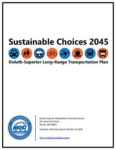With Sustainable Connections 2045 we are updating the Long Range Transportation Plan (LRTP) for the Duluth, Minnesota, and Superior, Wisconsin, urbanized area. The LRTP presents a long-range (25 year) strategy to guide the effective investment of public funds for multi-modal transportation infrastructure throughout the Duluth-Superior area. It is updated every five years in accordance with federal and state requirements, and reflects local planning initiatives and incorporates public input.
Sustainable Connections 2045 also provides the foundation for the annual development of the Duluth and Superior Transportation Improvement Programs (TIPs), short-range capital improvement programs that implement some of the needed highway, transit and bikeway projects identified in the project lists, as well as for the MIC’s annual work program activities. Topics that Sustainable Connections 2045 will address include:
• Transportation priorities, goals and objectives for the Duluth-Superior metro
• Census-based adjustments to population, employment and travel data
• Update of the MIC area urban boundary and functional classification changes
• Update the travel-demand model to identify current and future deficiencies in the road network
• Safety, efficiency and connectivity of the multimodal transportation network
• Technology acquisition and partnership strategy in support of performance-based planning
• Proposed system improvements
• Fiscally constrained projects
• Financial analysis
• Public involvement process for developing the 2045 LRTP
Key Issues
Looking ahead 25 years, here are some of the main issues we’ll be facing:
• There’s a Lot of Infrastructure Our transportation system includes all the roads, sidewalks and pedestrian paths, bikeways, railroads, shipping channels and port facilities, airports, transit facilities, bridges; traffic lights and signs, as well as maintenance equipment, safety systems and more, that support the movement of people and goods.
• It’s Getting More ExpensiveThe costs of building and maintaining transportation infrastructure are rising every year. Between 2003 and 2016 construction costs nationally have grown by 68%.
• Funding Shortfalls are Projected Revenue levels have been decreasing, costs have been increasing, and the Twin Ports is projected to have more than $1 Billion in unfunded maintenance projects by 2040.
• Our Population is Not Growing The number of people who live in the Duluth-Superior area has not increased for approximately 40 years—which means the per-person tax burden to pay for our infrastructure is increasing.
• We’re Getting Older In 2010 over 25% of the MIC area was 55 years of age and older, that is projected to increase to 37.5% by 2040. This has significant impacts on our tax revenues as well as the transportation needs of our community members.
• Many of Us Don’t Drive, or are Seeking Alternatives A significant number of people who live here don’t own vehicles (up to 39% of households in some neighborhoods); many others are too young, too old, or unable to drive (and still have places to go); and a growing number of people are seeking alternatives to driving (for reasons of lifestyle, health, finances or environmental impact).
 transportation system that not only supports the diverse needs of people and commerce but is also economically, socially, and environmentally sustainable over time.
transportation system that not only supports the diverse needs of people and commerce but is also economically, socially, and environmentally sustainable over time.

